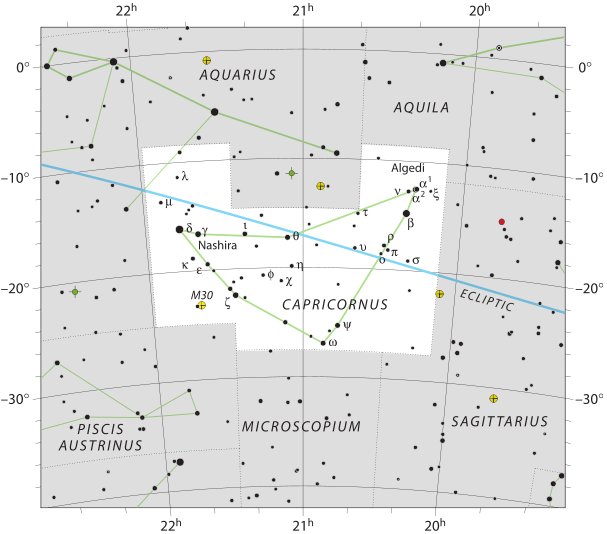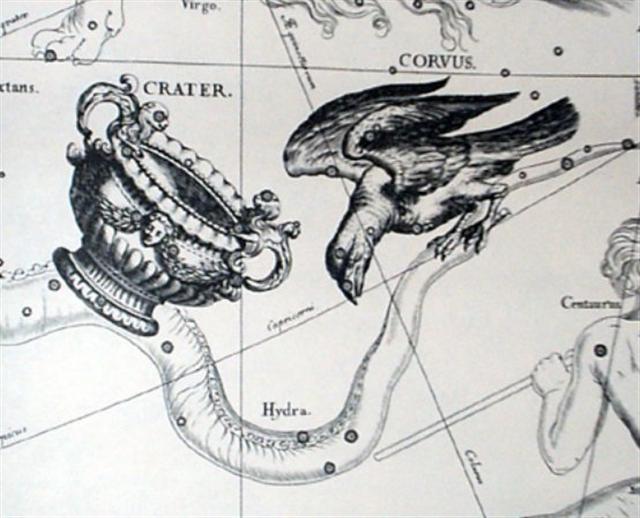According to Graves Zeus was born at midwinter when the Sun reached the Capricornus (Aegipan) constellation: ... The tradition preserved by Hyginus in his Poetic Astronomy that the constellation Capricorn ('He-goat') was Zeus's foster-brother Aegipan, the Kid of the Goat Amalthea whose horn Zeus also placed among the stars, shows that Zeus was born at mid-winter when the Sun entered the house of Capricorn ...
But, we can see, DECEMBER 21 - when Castor culminated at midnight - was in the Aquarius constellation. The first of my listed stars in the Capricorn is ξ.
This should therefore be where the Sun entered the house of his foster-brother.
... That the Sun-gods Dionysus, Apollo and Mithras were all also reputedly born at the Winter solstice is well known, and the Christian Church first fixed the Nativity feast of Jesus Christ at the same season, in the year A.D. 273. St. Chrysostom, a century later, said that the intention was that 'while the heathen were busied with their profane rites the Christians might perform their holy ones without disturbance', but justified the date as suitable for one who was 'the Sun of Righteousness' ...
In Roman times 'December 24 coincided with the time when the Sun reached ξ Capricorni. This place was apparently outside the reach of the text on the K tablet, but close to the Full Moon was the opposite side of the year. NOVEMBER 17 (321) - 183 = 138 (MAY 18):
... needfire ceremonies usually take place near the summer solstice (the Feast of St. John) ... but they occur in several other seasons as well. The summer date of the rite and its accompanying festival have to do, among other things, with fertility, as can can clearly be seen in a variant from the valley of the Moselle preserved for us by Jakob Grimm. Each household in the village was constrained to contribute a shock of straw to the nearby high place, Stromberg, where the males went at evening while the females went to a spring lower down on the slope. A huge wheel was wrapped with this straw. An axle run through the wheel served as the handles for those who were to guide it on its downward plunge. The mayor of a nearby town kindled the straw, for which office he was rewarded with a basketful of cherries. All the men kindled torches and some followed the burning orb as it was released downhill to shouts of joy. The women at the spring echoed these shouts as the wheel rushed by them. Often the fire went out of its own accord before it reached the river, but should the waters of the river extinguish it, an abundant vintage was forecast for that year ... (Thomas D. Worthen, The Myth of Replacement. Stars, Gods, and Order in the Universe.)
... In the Gospel of Mark III.17, the 'twins' James and John, the sons of Zebedee, are given by Jesus the name of Boanerges, which the Evangelist explains as meaning 'Sons of Thunder'. This was long overlooked but eventually became the title of a work by a distinguished scholar, too soon forgotten, Rendel Harris. Here the Thunder Twins were shown to exist in cultures as different as Greece, Scandinavia and Peru. They call to mind the roles of Magni and Modi, not actually called twins, but successors of Thor, in Ragnarok. But to quote from Harris: We have shown that it does not necessarily follow that when the parenthood of the Thunder is recognized, it necessarily extends to both of the twins. The Dioscuri may be called unitedly, Sons of Zeus; but a closer investigation shows conclusively that there was a tendency in the early Greek cults to regard one twin as of divine parentage, and the other of human. Thus Castor is credited to Tyndareus, Pollux to Zeus ... The extra child made the trouble, and was credited to an outside source. Only later will the difficulty of discrimination lead to the recognition of both as Sky-boys or Thunder-boys. An instance from a remote civilization will show that this is the right view to take. For example, Arriaga, in his 'Extirpation of Idolatry in Peru' tells us that 'when two children are produced at one birth, which they call Chuchos or Curi, and in el Cuzco Taqui Hua-hua, they hold it for an impious and abominable occurrence, and they say, that one of them is the child of the Lightning, and require a severe penance, as if they had committed a great sin'. And it is interesting to note that when the Peruvians, of whom Arriaga speaks, became Christians, they replaced the name of Son of Thunder, given to one of the twins, by the name of Santiago, having learnt from their Spanish (missionary) teachers that St. James (Santiago) and St. John had been called Sons of Thunder by our Lord, a phrase which these Peruvian Indians seem to have understood, where the great commentators of the Christian Church had missed the meaning ... Another curious and somewhat similar transfer of the language of the Marcan story in the folk-lore of a people, distant both in time and place ... will be found, even at the present day, amongst the Danes ... Besides the conventional flint axes and celts, which commonly pass as thunder-missiles all over the world, the Danes regard the fossil sea-urchin as a thunderstone, and give it a peculiar name. Such stones are named in Salling, sebedaei-stones, s'bedaei; in North Salling they are called sepadeie-stones. In Norbaek, in the district of Viborg, the peasantry called them Zebedee stones! At Jebjerg, in the parish of Cerum, district of Randers, they called them sebedei-stones ... The name that is given to these thunderstones is, therefore, very well established, and it seems certain that it is derived from the reference to the Sons of Zebedee in the Gospel as sons of Thunder. The Danish peasant, like the Peruvian savage, recognised at once what was meant by Boanerges, and called his thunderstone after its patron saint. This might have given pause to later hyperscholars like Bultmann, before they proceeded to 'de-mythologize' the Bible. One never knows what one treads underfoot ... (Hamlet's Mill)
... Again they went on and reached Hanga Hoonu. They saw it, looked around, and gave the name 'Hanga Hoonu A Hau Maka'. On the same day, when they had reached the Bay of Turtles, they made camp and rested. They all saw the fish that were there, that were present in large numbers - Ah! Then they all went into the water, moved toward the shore, and threw the fish (with their hands) onto the dry land. There were great numbers (? ka-mea-ro) of fish. There were tutuhi, paparava, and tahe mata pukupuku. Those were the three kinds of fish. After they had thrown the fish on the beach, Ira said, 'Make a fire and prepare the fish!' When he saw that there was no fire, Ira said, 'One of you go and bring the fire from Hanga Te Pau!' One of the young men went to the fire, took the fire and provisions (from the boat), turned around, and went back to Hanga Hoonu. When he arrived there, he sat down. They prepared the fish in the fire on the flat rocks, cooked them, and ate until they were completely satisfied. Then they gave the name 'The rock, where (the fish) were prepared in the fire with makoi (fruit of Thespesia populnea?) belongs to Ira' (Te Papa Tunu Makoi A Ira). They remained in Hanga Hoonu for five days ... According to Manuscript E this event happened somewhere in the interval from Anakena 18 (when the Explorers left Hanga Takaure) to Anakena 23 (when they reached Rangi Meamea). It is stated that they remained in Hanga Hoonu for 5 days. We can translate these dates to "July 18 - 22:
The creator of the K text seems to have put JUNE 30 - with heliacal Sirius and Alkes - where side a changes to side b, at Anakena 23 where the Explorers reached Rangi Meamea.
From dry Alkes to Situla (κ Aquarii) there were 177 (= 6 * 29½) nights:
|
||||||||||||||||||||||||||||||||||||||||||||||||||||||||||||||||||||||||||||||||||||||||||||||||||||||||||||||||||||||||||||||||||||||||||||||||||||||||||||||||||||||||||||||||||||||||||||||||||||||||||||||||||||||||||||||||||||||||||||||||||||||||||
























